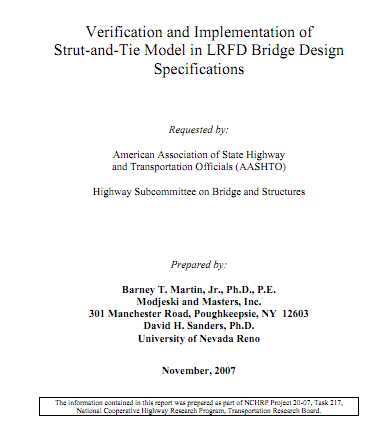Verification and Implementation of Strut and Tie Model in LRFD Bridge Design Specifications

Verification and Implementation of Strut-and-Tie Model in LRFD Bridge Design
Specifications
Requested by:
American Association of State Highway and Transportation Officials (AASHTO)
Highway Subcommittee on Bridge and Structures
Prepared by:
Barney T. Martin, Jr., Ph.D., P.E. Modjeski and Masters, Inc.
301 Manchester Road, Poughkeepsie, NY 12603 David H. Sanders, Ph.D.
University of Nevada Reno
November, 2007
1.1 INTRODUCTION Strut-and-tie modeling (STM) is an approach used to design discontinuity regions (D-regions) in reinforced and prestressed concrete structures. A STM reduces complex states of stress within a D-region of a reinforced or prestressed concrete member into a truss comprised of simple, uniaxial stress paths. Each uniaxial stress path is considered a member of the STM. Members of the STM subjected to tensile stresses are called ties and represent the location where reinforcement should be placed. STM members subjected to compression are called struts. The intersection points of struts and ties are called nodes. Knowing the forces acting on the boundaries of the STM, the forces in each of the truss members can be determined using basic truss theory.
Download
http://s18.alxa.net/s18/srvs2/01/Ver...Tie.Method.rar